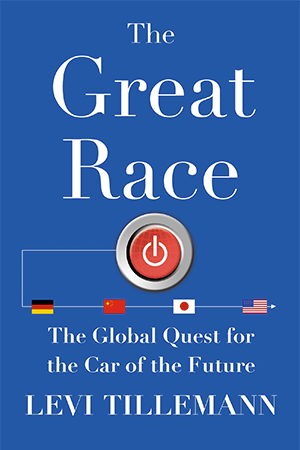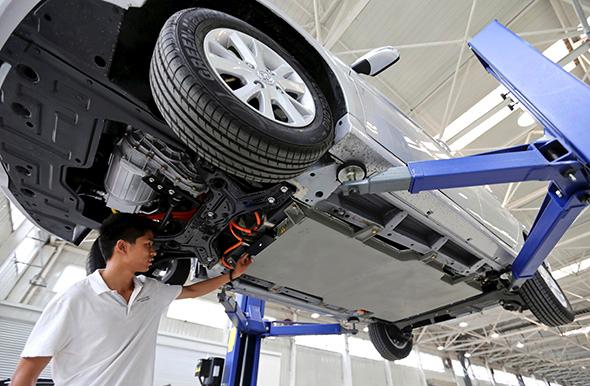Adapted from The Great Race: The Global Quest for the Car of the Future by Levi Tillemann, out now from Simon & Schuster.
China’s accession to the World Trade Organization in 2001 signified the beginning of what some called its “Golden Decade.” It was like lighting a fuse. Economic growth skyrocketed, energy demand swelled, and China’s automotive market surged year after year. To many American hedge fund managers and private equity investors, it appeared China could do anything. Seemingly overnight, Shanghai had erupted from the mud flats of Pudong into one of the world’s most modern cities. While Europe, Japan, and America struggled through the Great Recession, China was still on an economic tear. The Communist Party was crisscrossing the country with the world’s largest network of bullet trains, and China’s results always seemed to outstrip Western expectations. For the Chinese themselves, these outcomes had started to seem rather pedestrian—they were expected. Huang Yonghe, the chief engineer of the Chinese Automotive Technology Research Center, wistfully remembered the auto sector’s 40 percent year-on-year growth during that Golden Decade. “We thought it was normal,” he said.
But almost all of this growth was based on technological catch up—assimilating Western knowledge into Chinese markets. China’s Minister of Science and Technology Wan Gang believed that his country could do more. He wanted to leapfrog the West by dominating the emerging market for electric vehicles. Surely, thought many academics, policymakers, but especially investors, if Wan Gang and China’s band of economic wizards sought to overtake the West in automotive technology, they could.
But even sophisticated observers failed to appreciate the sheer complexity of building a new transportation system based on the electric car, and the fact that Beijing had not really developed an integrated strategy to accomplish this feat. Many of the international financiers who invested billions of dollars for hedge funds, private equity groups, and banks had latched on to Wan Gang’s “China first” thesis. But they didn’t understand much about China, and even less about China’s EV market. All they understood was that they didn’t want to miss out on the world-leading EV transformation that China’s government—as well as the Western news media—was talking so much about.
They had heard that the sponsorship for China’s EV program came right from the top. “[China’s president] Hu [Jintao] personally inserted the private subsidy into the program,” recalled one Chinese automotive industry insider. Industrial transformations of this magnitude didn’t just pop up every day, and the potential for growth was mind-boggling. The global auto industry represented an economy as big as India. And the transformation of that sector meant that that market was up for grabs. Nowhere was the potential more spectacular than in China.
It was easy to overlook Japanese and American efforts in the face of China’s booming auto market. After a decade of anemic growth, Japan just wasn’t as sexy as China. It was seen as the “sick man of Asia.” America’s industry was also out of favor. Its largest automaker was now derided as “Government Motors.”
But Japan and America were the real driving forces of this transformation. In California, the state’s Air Resource Board was meticulously creating the policy incentives that would force automakers from around the world to build and sell electric cars—not only in California, but other states like New York, Oregon, and Massachusetts. In Japan, bureaucrats were coordinating with industry to fine-tune the mechanisms to launch their EV sector on a sustainable path of growth. Not least, Japan was investing prodigiously in an extensive network of fast chargers around the country. Nothing as concrete or strategic was taking place in China.
Ironically, many of the same American capitalists who turned up their nose at Washington’s meddling with GM and Chrysler were quite enchanted by China’s corporatism. In China’s authoritarian economy, everything was so efficient. Government could just make things happen. Why should EVs be any different?
A steady drumbeat of media sensationalism reinforced this narrative. But, on the ground in China, it was hard to shake the feeling that none of the major players really understood how to meet these expectations. No one was in charge, and none of them really knew what they were doing. The Communist Party wanted China’s companies to build EVs, and believed that they were going to be, somehow, easier to perfect than vehicles powered by an internal combustion engine. They figured that the necessary motors, inverters, and lithium-ion batteries had all reached a sufficient degree of maturity. Where necessary, they thought, they could force foreign companies to yield up valuable technology in exchange for access to the Chinese market. In order to curry favor with Beijing, Chinese auto companies made sure they looked busy on the research, development, and deployment side of things.
But where was the charging infrastructure? What if foreigners decided not to barter their technology endowment for access to China’s market? Where would the technology come from? And who would buy these indigenous Chinese EVs? All these questions were left unanswered.
In an ideal world, the infrastructure to charge EVs would have been sponsored or mandated by the government. And theoretically, these facilities could be installed quite cheaply. China was already building massive amounts of new housing, parking, and roads. With some smart regulation, the ducting and wires for EV charging could have been integrated into this expanding stock of capital.

If China wanted low-cost, high-quality EVs, companies should have been free to procure technology abroad without risking access to lucrative subsidies—just as they were in California. Indeed, had China followed California’s lead, foreign automakers would have been encouraged—no, required—to compete with China’s local companies to produce the best, most attractive EVs possible for the Chinese market. All this foreign competition would have likely generated business models to entice China’s wealthy buyers, a social class already enamored with foreign automobiles, to purchase high-quality electric cars. Indeed, there might well have been a Chinese Tesla.
But instead of running a race for the car of the future, China was on its own domestic circuit. With so little exposure to international markets, they were never going to emerge as a true contender in the global EV space.
In fact, Chinese EV makers rarely had to contend domestically with one another either. On the contrary, it was the provincial and municipal mayors and governors who were fiercely competitive. Local officials believed that the best means to ensure the survival of a local EV manufacturer was to put up walls against competition both foreign and domestic. And so companies regularly enjoyed city, provincial, or regional monopolies on EV sales. While some domestic companies were genuinely excited about the prospects for EVs, others were more tentative. But for largely political reasons, they all charged wildly ahead—many of them without the most elementary understanding of how to build a quality car, never mind an electric car.
Many of the companies that were supposed to drive China’s EV market had been set up practically overnight in response to the central government’s announcement of massive subsidies. One of these was the Beijing Electric Vehicle Company. The company’s chief technology officer Frank Liao had lived in the United States as a young man, learned fluent English, obtained a Ph.D. from University of Wisconsin and worked on some high profile electric vehicles startups. He was even a consultant on the famed – and doomed – GM EV1 project. Liao had a hearty laugh and held the distinction of being perhaps the only person in Beijing who actually stopped his car at crosswalks, where pedestrians regarded him with deep bewilderment, even suspicion, as if he were waiting to mow them down.
Liao knew that the Beijing Electric Vehicles Company had money, it had land grants, it had subsidies, it had support from the local and national government, and it had leadership with industry experience. It even had some high quality technology platforms that the company had recently purchased from the ailing, and soon to be bankrupt, Saab Automobile company. But from the inside of China’s industrial juggernaut, he had little confidence that China’s effort to leapfrog the West would succeed. The entire undertaking was a huge gamble—and infinitely more complex than those hedge fund managers sitting in their leather lined Wall St. offices understood. Yet the American media and financial community were still in thrall to the “China First” thesis. They remained so long after the Chinese themselves knew that their EV program was on an ugly crash course.
Adapted from The Great Race: The Global Quest for the Car of the Future by Levi Tillemann. Copyright © 2015 by Levi Tillemann-Dick. Reprinted by permission of Simon & Schuster, Inc.
